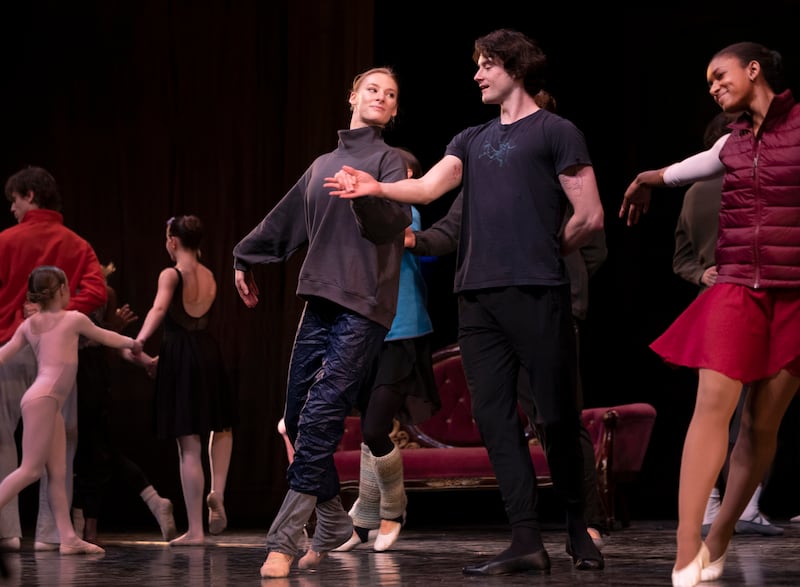Photo by Laura Seitz | Ballet West rehearses for the 2023 production of “The Nutcracker."
There are many things that drew Pieter Gunning, a ballet dancer and Dutch citizen, to move more than 5,000 miles from the Netherlands to train at Utah’s Frederick Quinney Lawson Ballet West Academy—but it was all made possible by the academy’s efforts to create a diverse program of world-class talent.
Ballet West Academy has worked to become certified as a student exchange visa program (SEVP) for the last five years and finally received approval in Spring 2023. SEVP programs help prospective students apply for visas and admit them once they arrive in the United States, and Ballet West Academy welcomed their first international students in August.
It’s not difficult to get a visa for an accomplished dancer, says Evelyn Cisneros-Legate—Ballet West Academy’s director and the first Mexican-American prima ballerina in the U.S.—and the academy has always had international dancers in its company. Now, her focus is on helping students gain that same opportunity.
“In sharp contrast to prior years, 75 percent of our main company has trained within our academy at some point,” Cisneros-Legate says. “With that change, we want to give the broadest pool to promote from, to support our diversity initiatives and attract the highest artistic quality for the company.”
Unlocking opportunities for global talent
Obtaining the SEVP label was much more strenuous than helping dancers obtain professional visas, says Ballet West Academy Director of Business Operations Sarah Taylor.
“The approval process included site visits where we had to prove our artistic and curriculum efforts,” she says. “We proved you can’t get our training anywhere else and that we meet a world-class standard.”
Cisneros-Legate says that part of the motivation to seek this accreditation was external, as international students have been reaching out to her and the academy for years in hopes of being admitted to the program.
At the time of this writing, three visas have been issued. Gunning was the first to receive one.

Photo by Laura Seitz | Ballet West rehearses for the 2023 production of “The Nutcracker."
“[Gunning] had expressed interest in our program long before we could accept his visa,” Cisneros-Legate says. “When we were cleared in May, I called him. To our surprise, he was able to move here a few months later.”
In the last eight years, Gunning has danced at the Royal Conservatoire of the Hague, the Hamburg Ballet and the Orlando Ballet in Florida. He had just moved back to the Netherlands when he got Cisneros-Legate’s call.
Dance, sleep, repeat
Inclusion initiatives at Ballet West expand beyond its classrooms. The academy has made a concerted effort to support dancers both in the studio and at home—literally. This commitment is shown through the purchase and renovation of a building just over one mile from the academy that serves as a residence option for students. It opened this season.
“It’s important for us to be on the same playing field as the larger, more prestigious companies, which all have housing that supports their academies,” Cisneros-Legate says.
The apartments are fully furnished, in a walkable area and near public transportation. Rent is fixed between $650 and $700 monthly, including utilities.
Though other academies have housing, Gunning says Ballet West’s stands out among the competition.
“The Hamburg Ballet School has a boarding school that was developed more for younger students,” he says. “It was a great option for kids traveling without parents, who needed somewhere with guidance.”
While Ballet West does have some younger students living in its apartment building, there are a variety of living options to choose from. Gunning lives in a shared apartment, which has helped introduce him to other dancers while encouraging his independence. Having this housing option made Gunning’s move back to the U.S. considerably easier.
“Just the existence of this building made moving again a much smaller ask,” Gunning continues. “There are more strict rules for foreigners looking for housing in the U.S., and we can easily get tangled up in U.S. guarantor requirements. … I’m very grateful that Ballet West offered me a place here. There really wasn’t too much to arrange.”

Photo by Laura Seitz | Ballet West rehearses for the 2023 production of “The Nutcracker."
Ballet West’s housing isn’t just for students coming from across the globe, though. Taylor says many people living in the apartments are from neighboring states or are students just trying to avoid a commute.
“Anyone who is a student at Ballet West can live here,” she says. “We have a few that used to drive up from Utah County to our Salt Lake location that now live in the apartments.”
Taylor hints that the construction isn’t stopping at housing.
“Other ballet academies at this level are often coastal,” she says. “We’re a regional hub here in Salt Lake, but we’re not stopping there. … We’re exploring additional expansion of our campuses, both within Utah and outside of the state.”
Dreams take center stage
In the meantime, Taylor says Ballet West has made a serious commitment to making dance more equitable.
“We’ve already eliminated a lot of the costs associated with dance education, from performance and costume fees to ticket obligations,” she says. “Expanding general financial aid and scholarships are a big part of how we plan to grow and continue to support our community.”
That attitude also stood out from all of Gunning’s other dance academies.
“Favoritism in dance is common,” Gunning says. “People will often only work with and invest in their favorites. But at Ballet West, they see potential in all of us. The faculty and artistic staff go out of their way to ensure that everyone here gets a chance at the same level of education. I love it when [dance is] collegial. Even though we do it by ourselves, dance is not a solo art.”
At Ballet West, Gunning says he and the other international students he’s talked to felt immediately accepted. Most of all, he’s been struck by how many dancers want to stay involved in the academy even after their training and onstage careers are complete.
“Even when their dance career is over, they find a different role within the organization,” Gunning says. “That, to me, is the most telling thing about the work environment—people not only want to be here, but they want to stay here. There is true loyalty.”
That’s just not the case at most academies, Gunning continues, claiming it isn’t uncommon for companies to switch artistic directors every year. But Ballet West’s reputation was built in direct opposition to that status quo, Taylor says.
“Our artistic director Adam Sklute created, dare I say, a friendly company,” she says. “Everyone is so excited to work and participate, and those positive experiences really last.”
While dance careers can be volatile and constantly in flux, Gunning says that if it were up to him, he’d stay in Utah for a long time.
“Dance education and careers take up your whole life,” he says. “You’re friends with dancers, you live with dancers, you’re always talking and thinking about dance. Living this life in the right environment was and is very important to me. I found it at Ballet West.”

